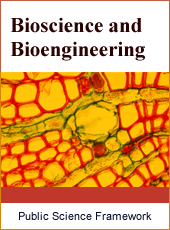Bioscience and Bioengineering
Articles Information
Bioscience and Bioengineering, Vol.1, No.3, Aug. 2015, Pub. Date: Jul. 15, 2015
An Improvise Easy Digital Method for Palmar and Plantar Dermatoglyphics
Pages: 85-89 Views: 5999 Downloads: 2069
[01]
Oghenemavwe Ese Loveday, Department of Anatomy, Faculty of Basic Medical Sciences, College of Health Sciences, University of Port Harcourt, Port Harcourt, Nigeria.
[02]
Osaat Roseline Sunday, Department of Anatomy, Faculty of Basic Medical Sciences, College of Health Sciences, University of Port Harcourt, Port Harcourt, Nigeria.
The accuracy of dermatoglyphics and its application as a scientific tool depends on the quality and clarity the dermal prints. The ink method which is the commonly used can result in poor quality print due to over-inking and cause inconvenience to subjects. Digital techniques using customized Biometric Machine are usually expensive especially for researchers in the developing world. Therefore, the study aims at introducing an easy digital procedure that can be conveniently use to produce good quality print and accurate result. This new method uses Hp digital scanner and Autocad computer software. The scanner is used to capture the image of the dermal patterns of the fingers, palm, toes and sole while the autocad software program is capable of measuring the angles and counting the ridges automatically. The accuracy of the method was tested by evaluating a-b ridge count and atd angle of 30 samples using the ink method and this new method. There was significant difference in the result (p<0.05). This difference was as a result of our ability to clearly identify the exact triradius point and the ridges which resulted in accurate measurement of angles and counting of ridges. We therefore recommend this method in clinical, forensic and research settings in both rural and urban areas of developing countries where access to high-tech biometric equipment is limited due to cost
Dermatoglyphics, Digital, Method, Autocad, Scanner
[01]
Cummins H. and Midlo C. (1943). Finger prints, Palm and soles. An introduction to dermatoglyphics Blakiston, Philadelphia.
[02]
Reed T. and Meier R. (1990). How to take dermatoglyphic prints. Taking Dermatoglyphic print: A Self-instruction manual. Supplement to the Newsletter of the American Dermatoglyphics Association, 1-45.
[03]
Pratibha R., Abhilash P.R., Herald J.S., Anuja N., Priya P. Chandrasekar T., Sentamilselvi G., Janaki V.R. (2011). Conventional Dermatoglyphics – Revived Concept: A Review. International Journal of Pharmacology and Biological Sciences, 2(3):446-457.
[04]
Ozyurt B., Songur A., Sarislmaz M., Akyol O., Namli M., Demorel R. (2010). Dermatoglyphics as markers of prenatal disturbances in Schizophrenia: a case-control study Turk. Journal of Medical Sciences, 40(6):917-924.
[05]
Boroffice R.A. (1978). Down’s Syndrome in Nigeria: dermatoglyphic analysis of 50 cases. Nigeria Medical Journal, 8(6):571-6.
[06]
Arrieta M.I., Martinez B., Criado B., Simon A., Salazar L., Lostao C.M. (1990). Dermatoglyphic analysis of autistic Basque children. American Journal of Medical Genetic, 35(1):1-9.
[07]
Milicic J., Bujas P.Z., Bozikov J. (2003). Dermatoglyphs of digito-palmar complex in autistic disorder: family analysis. Croatia Medical Journal, 44(4):469-76.
[08]
Oladipo G.S., Okoh P.D., Oghenemavwe L.E., Yorkum L.K. (2013). Dermatoglyphic Patterns of Autistic Children in Nigeria. Journal of Biology, Agriculture and Healthcare, 3(7):80-83.
[09]
Stosljevic M. and Adamovic M. (2013). Dermatoglyphic characteristics of digito-palmar complex in autistic boys in Serbia. Vojnosanit Pregl, 70(4):386-390.
[10]
Rosa A., Gutierrez B., Guerra A., Arisa B., Fananas L. (2001). Dermatoglyphics and abnormal palmar flexion creases as markers of early prenatal stress in children with Idiopathic Intellectual disability. Journal of Intellectual Disability Research, 45(5):416-23.
[11]
Seema M.A., Gandhi D., Singh M. (2012). Dermatoglyphics – Study and Review of Literature. Novel Science International Journal of Medical Science, 1(6):191-198.
[12]
Gyenis G. (2000). A Short history and some results of the dermatoglyphic studies in Hungary, Acta Biologica Szegediensis, 44 (1-4):135-138.
[13]
Sharma M.K., Jhawar P., Sharma H., Sharma S., Kalavatia I. (2012). Dermatoglyphics an attempt to predict Downs syndrome. International Journal of Biological & Medical Research, 3(2):1631-1635.
[14]
Sharma M.K. and Sharma H. (2012). Dermatoglyphics: A Diagnostic Tool to Predict Diabetes. Journal of Clinical and Diagnostics Research, 6(3):327-332.
[15]
Osunwoke E.A., Ordu K.S., Hart J., Esomonu C., Tamunokuro F.B. (2008). A Study on the Dermatoglyphic Patterns of Okrika and Ikwerre Ethnic Groups of Nigeria. Scientia Africana, 7(2):143-147.
[16]
Gupta R.K. and Gupta A.K. (2013). New, Easy and Effective Method to take Dermatoglyphic Prints. National Journal of Medical Research, 3(1):45-47.
[17]
Macarthur J.W., Ford N. (1937). A Biological study of the dionne quintuplets all Identical Set. Univ. Toronto Studies, Child Development Series, Univ. Toronto Press. 11: 49.
[18]
NEC (2015). LiveScan Overview. http://ad.nec.com/en_All/solution/security-and-public-safety/biometrics/livescan-overview.html. Retrieved 15/03/2015.

ISSN Print: 2381-7690
ISSN Online: 2381-7704
Current Issue:
Vol. 6, Issue 3, September Submit a Manuscript Join Editorial Board Join Reviewer Team
ISSN Online: 2381-7704
Current Issue:
Vol. 6, Issue 3, September Submit a Manuscript Join Editorial Board Join Reviewer Team
| About This Journal |
| All Issues |
| Open Access |
| Indexing |
| Payment Information |
| Author Guidelines |
| Review Process |
| Publication Ethics |
| Editorial Board |
| Peer Reviewers |


